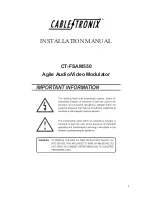
2.4 Description
The twin transmodulator cassette is a QPSK-converter, which converts all sta-
tions modulated according to DVB-S / DVB-S2 standard into two QAM-modulat-
ed cable signals. The cassette has two digital SAT IF inputs and an HF output. It
is equipped with two channel strips (“
A
” and “
B
”). The channel strips consist of
the digital tuners, the digital signal preparation units and the output converter.
The channel strips are indicated in the head-end station display with “
Bx …A
”
and “
Bx …B
”. Using an adequate CA module encoded channels can be decod-
ed via channel strip “
A
”. The control of the cassette takes place via the control
unit of the head-end station.
Two LEDs indicate if the respective channel strip is switched on (LED illuminates)
or off, and also provide an indication of the signal quality based on their
colour. Additionally the quality of the data stream received is displayed
(“
CN…
”).
The integrated TPS module (Transport Stream Processing) processes the data
from the demodulated transport streams. This enables service information (NIT –
Network Information Table) to be changed, data rates to be increased (stuffing)
and for individual stations to be deleted from the transport stream (thus optimis-
ing bandwidth for the other stations being transmitted).
The HF output signals are sent through the HF output of the cassette to the output
collector. The common output level of the channel strips can be set at the output
collector.
When the head-end station is switched on, the two-line LC display shows the
software version of the control unit.
To operate this cassette the software version of the control unit must be “
V 37
”
or higher. You can find the current operating software for the control unit and
the cassette, the software “
BE-Flash
” and the current assembly instructions on the
website “
www.gss.tv
”.
The cassette is designed for use in the following head-end stations:
– STC
1200
– STC
316
– STR
19-8







































